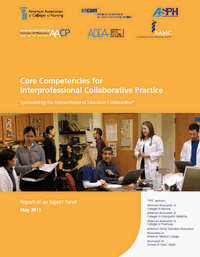Competencies for interprofessional collaboration
Competencies for interprofessional collaboration; A framework for assessment of simulation exercises
By Dr. Kelly Goudreau, DSN, RN, ACNS-BC
Associate Director for Patient Care Services/Nurse executive
VA Southern Oregon Rehabilitation Center & Clinics

PORTLAND, OR - Practice to achieve competence is a core tenet of simulation education. On Feb. 16 and 17, the Health Resources and Services Administration (HRSA) shared a draft document called Core Competencies for Interprofessional Collaborative Practice at an invitation-only event in Washington, DC. HRSA is the primary Federal agency for improving access to health care services for people who are uninsured, isolated or medically vulnerable.
Attendees included a host of people from both educational programs and clinical practice, including representatives from the Centers for Medicare and Medicaid Services, The Joint Commission, numerous professional organizations, various accreditation agencies, certification agencies, and the VA. HRSA hosted the meeting to garner first impressions about the document from participants, identify gaps in the competencies, suggest ways in which to bridge those gaps, and identify ways in which the competencies could be fully integrated into the context of both current practice and educational settings. Initially, VISN 20 will be using the Interprofessional Collaborative Practice competencies as an evaluation framework for the simulation program across the VISN.
An expert panel convened by the Interprofessional Education Collaborative (IPEC) created the four core competency domains, through a process of evidence-based review. They are:
Values/ethics for interprofessional practice - Work with individuals of other professions to maintain a climate of mutual respect and shared values.
Roles/responsibilities for collaborative practice - Use the knowledge of one's own role and the roles of other professions to appropriately assess and address the health care needs of the patients and populations served.
Interprofessional communication - Communicate with patients, families, communities and other health professionals in a responsive and responsible manner that supports a team approach to maintaining health and treatment of disease.
Interprofessional teamwork and team-based care - Apply relationship-building values and the principles of team dynamics to effectively perform in different team roles and to plan and deliver patient/population centered care that is safe, timely, efficient, effective and equitable.
These four domains have specific expectations within them that are defined more clearly and in measurable terms. However, can these competencies be used within current simulation exercises and scenarios to assess and frame the concept of teamwork and collaboration?
The official publication of the competencies was published in May. To download the document, visit the AAMC Publicatons page. Clinical simulationists and other practitioners are encouraged to explore how these competencies can fit within local programs and efforts at interprofessional education in a practicing simulation environment.



















